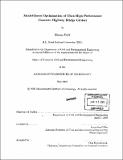| dc.contributor.advisor | Franz-Josef Ulm. | en_US |
| dc.contributor.author | Park, Hesson, 1979- | en_US |
| dc.contributor.other | Massachusetts Institute of Technology. Dept. of Civil and Environmental Engineering. | en_US |
| dc.date.accessioned | 2008-01-10T16:19:19Z | |
| dc.date.available | 2008-01-10T16:19:19Z | |
| dc.date.copyright | 2003 | en_US |
| dc.date.issued | 2003 | en_US |
| dc.identifier.uri | http://hdl.handle.net/1721.1/40024 | |
| dc.description | Thesis (S.M.)--Massachusetts Institute of Technology, Dept. of Civil and Environmental Engineering, 2003. | en_US |
| dc.description | Includes bibliographical references (p. 135-138). | en_US |
| dc.description.abstract | Ultra High Performance Concrete (UHPC) represents a breakthrough for civil engineering materials. Compared to conventional concrete solutions, UHPC possesses such dramatic mechanical improvements that new design philosophies, safe guidelines, and design tools for UHPC structures are required to gain true acceptance in the global civil engineering design and construction community. The research presented in this report aims at contributing to this goal through the development of a comprehensive model-based optimization methodology and its application toward the design of UHPC highway bridge girders. At the core of the proposed model-based design strategy is a macroscopic two-phase UHPC material model, in which the brittle-plastic composite matrix and the elasto-plastic composite fiber reinforcement are modeled as two distinct and interacting phases, using a minimal number of model input parameters that are all accessible by a single notched tensile test. The UHPC model is combined with maximum crack width criteria, which aptly define the Service Limit State (SLS) and the Ultimate Strength Limit State (ULS) of UHPC structures, to yield a three step design strategy for UHPC bridge girders: 1) 1-D section design models suffice for initial estimates of section dimensions and design parameters (prestressing level, etc.). 2) A refined 2-D finite element model is employed for assessment of the global flexural and shear resistance of UHPC girders that is quantified in terms of admissible matrix plastic strains (normalized crack widths) at SLS and ULS. Finally, complete 3-D finite element simulations allow the study of localized 3-D stress and cracking states, which occurs as a result of punching shear in unreinforced UHPC slab systems or transfer of prestressing. Hence, a comprehensive method for the model-based design of UHPC structures is developed. Design solutions are proposed for prestressed double-tee sections for small and medium span highway bridge girders (21.3 - 36.6 m (70 - 120 ft)), which possess many advantages over conventional precast concrete solutions (reduction in height and weight, elimination of shear reinforcement, etc.), and which will ultimately translate into easier and faster construction processes, longer life spans with higher durability and less maintenance. | en_US |
| dc.description.statementofresponsibility | by Hesson Park. | en_US |
| dc.format.extent | 139 p. | en_US |
| dc.language.iso | eng | en_US |
| dc.publisher | Massachusetts Institute of Technology | en_US |
| dc.rights | M.I.T. theses are protected by copyright. They may be viewed from this source for any purpose, but reproduction or distribution in any format is prohibited without written permission. See provided URL for inquiries about permission. | en_US |
| dc.rights.uri | http://dspace.mit.edu/handle/1721.1/7582 | |
| dc.subject | Civil and Environmental Engineering. | en_US |
| dc.title | Model-based optimization of ultra high performance concrete highway bridge girders | en_US |
| dc.title.alternative | Model-based optimization of UHPC highway bridge girders | en_US |
| dc.type | Thesis | en_US |
| dc.description.degree | S.M. | en_US |
| dc.contributor.department | Massachusetts Institute of Technology. Department of Civil and Environmental Engineering | |
| dc.identifier.oclc | 52872493 | en_US |
